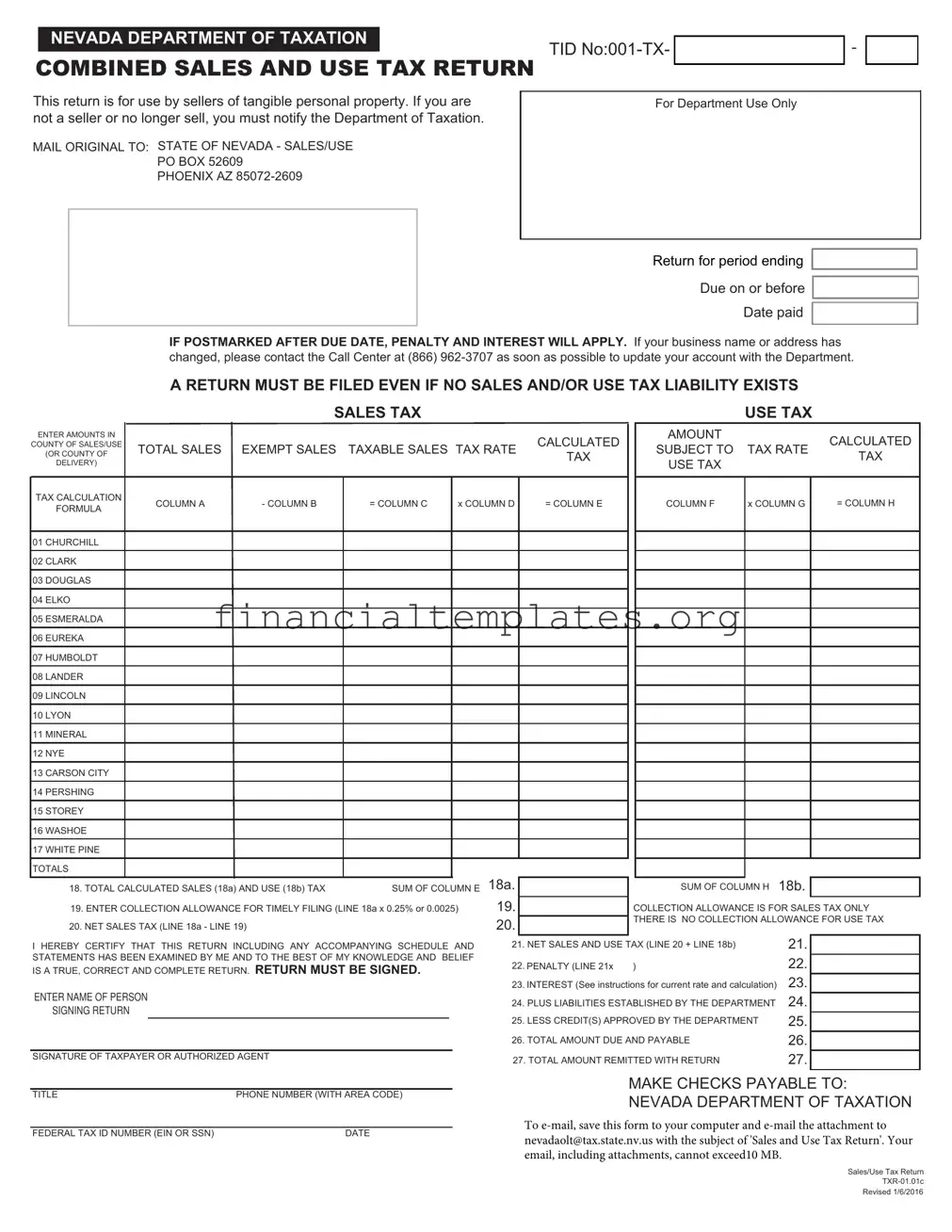The Nevada Department of Taxation's Combined Sales and Use Tax Return is quite similar to the California Sales and Use Tax Return. Both forms require businesses to report sales, deductions for exempt sales, and calculate the amount of sales and use tax owed. These forms focus on businesses selling tangible personal property and necessitate detailed breakdowns by county or district to determine the applicable tax rates. This meticulous reporting ensures that the correct amount of tax is collected and remitted to the state, tailored to the unique tax jurisdictional requirements within each state.
Another document that shares similarities with the Nevada State Tax form is the New York Sales and Use Tax Return. Like Nevada's form, it's designed for sellers of tangible goods, but it also accommodates service providers where applicable tax laws apply. Both require the report of total sales, exempt sales, and the calculation of taxable sales. They are thorough in ensuring businesses accurately report and remit taxes based on the specific tax rates applicable in various localities within the state, highlighting the emphasis on locality-specific taxation in sales and use tax law.
The Texas Sales and Use Tax Return parallels Nevada's in structure, focusing on the taxable transactions related to tangible personal property. Both forms necessitate the division of sales into total, exempt, and taxable categories, with subsequent tax calculations based on defined rates. The emphasis on geographic specificity is present in the Texas version, requiring sellers to report based on the location of sales to ensure compliance with county and city tax regulations, akin to Nevada's county-based reporting.
Florida's Sales and Use Tax Return also resembles Nevada's, with sections dedicated to reporting total sales, exempt transactions, and calculating taxes owed. Both states' forms emphasize the importance of distinguishing between types of sales to accurately apply tax rates. They cater to businesses engaged in selling tangible personal property but also cover other taxable activities under their respective state laws, underlining the broad applicability of sales and use tax requirements.
The Illinois Sales and Use Tax Return shares commonalities with the Nevada form, with both demanding detailed sales reporting and the breakdown of taxable versus exempt sales. The forms serve the purpose of collecting tax on retail sales of tangible personal property and certain services, and they require businesses to meticulously calculate the tax due, based on varied tax rates across different jurisdictions within the state. This complexity underscores the importance of accuracy in tax reporting and remittance.
Similar to the Nevada Sales and Use Tax Return, the Pennsylvania Sales and Use Tax Return requires retailers and service providers to itemize sales and calculate due taxes. These forms are integral to the state’s ability to collect taxes on a wide range of transactions involving tangible personal property. The requirement to differentiate between exempt and taxable sales is a key feature, guiding businesses through the process of determining their tax liability with precision.
The Colorado Sales and Use Tax Return, while serving a similar purpose as Nevada's, adapts to Colorado’s tax structure by requiring sellers to report state and local tax liabilities. Like Nevada's form, it focuses on the sale of tangible goods but also encompasses taxable services, emphasizing the collection of taxes based on jurisdiction-specific rates. This highlights the tailored approach states adopt in sales and use tax collection, adapting to local tax codes and jurisdictions.
Michigan's Sales and Use Tax Return also aligns closely with Nevada's form in its aim and structure. Both documents are essential for the reporting and remittance of taxes from the sale of tangible personal property. The forms necessitate detailed reporting of sales activities, categorizing them to identify taxable and exempt sales, thereby facilitating the accurate application of tax rates and ensuring compliance with state tax laws.
The Arizona Transaction Privilege Tax (TPT) Return shares similarities with the Nevada Sales and Use Tax Return, emphasizing taxable transactions related to tangible property. Though termed differently, Arizona’s TPT Return encompasses aspects of sales and use tax, requiring detailed reporting and calculation akin to Nevada’s form. Both forms underscore the importance of geographic and jurisdiction-specific reporting, reflecting the nuanced nature of tax obligations across different states.
Oregon, while not having a general sales and use tax, has specific tax forms for businesses engaged in activities that are taxable, such as the Corporate Activity Tax (CAT) Return. This form, though not a direct counterpart to Nevada’s Sales and Use Tax Return, is similar in its requirement for businesses to report transactions and calculate tax liabilities based on the rules specific to Oregon. This showcases the diverse approaches states take in taxing business activities, even in the absence of a traditional sales and use tax system.

